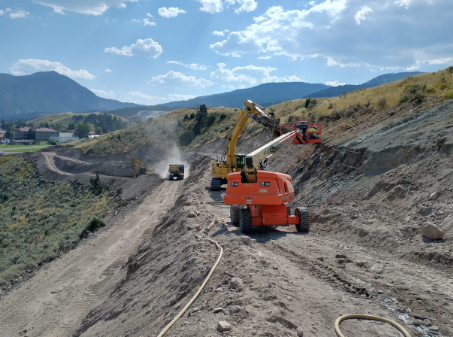Soil nailing is an innovative technique in geotechnical engineering used to stabilize existing slopes and soil masses. This method involves inserting reinforcing elements, or “nails,” into the soil to provide additional support and prevent displacement. By reinforcing the soil, soil nailing effectively mitigates the risk of landslides and other forms of erosion. This technique is widely employed in construction projects to ensure the stability and safety of slopes and excavations.
This method involves inserting steel bars, Know as soil nails, into a slope or wall to enhance stability. It is particularly effective for steep slopes where traditional methods may not be viable.
How it Works
The process starts by drilling holes into the slope at predetermined angles and depths tailored to the specific conditions of the soil and the slope’s characteristics. Steel bars are then inserted into these holes. Once in place, the space around the bars is filled with grout, securing the nails in the soil and creating a solid reinforcement that distributes tensile forces across a wide area. The outer surface is typically finished with a mesh or shotcrete to protect against weathering and further movement.
Benefits of Soil Nailing
Cost-Effectiveness and Flexibility
It offers a more cost-effective solution than other stabilizing methods, such as anchored retaining walls or large gravity walls. It requires fewer materials and can be adapted to various soil types and environmental conditions. Additionally, the installation process causes minimal disturbance to the surrounding area, making it ideal for sensitive environments or populated areas where space and noise are concerned.
Speed and Efficiency
The technique allows for quick installation, which is crucial when time is of the essence, such as during emergency landslide repairs or in fast-paced construction projects. The ability to rapidly stabilize a slope means that other construction activities can proceed with fewer delays, enhancing overall project efficiency.
Sustainability
It is seen as a sustainable option because it uses fewer resources than many traditional methods. The longevity of the materials used in nailing ensures that structures are durable and maintenance needs are minimized over time. This contributes to a lower environmental impact throughout the structure’s lifespan.
Installation Process
Planning and Design
The first step involves detailed planning and geotechnical analysis to assess the properties, slope geometry, and load requirements. This information is critical to designing an effective nailing system that can handle the specific stresses of the site.
Execution
Professional technicians drill and install nails. Precision is critical, as the angles and depths of the nails must be consistent with the design specifications to ensure effectiveness.
Testing and Monitoring
After installation, tests are conducted to verify the integrity of the soil nails. Ongoing monitoring may also be required to ensure the long-term stability of the slope, especially in areas with active geological changes.
It is a robust and reliable solution for managing slope stability and preventing erosion in various environments. Its advantages of cost-effectiveness, flexibility, and minimal environmental impact make it a preferred choice for many engineering projects. By understanding the fundamentals and applications of soil nailing, stakeholders can better appreciate its value in contemporary construction and geotechnical applications.
Professionals in the field continue to innovate and improve its techniques and materials, promising even greater efficiency and sustainability in future projects.


